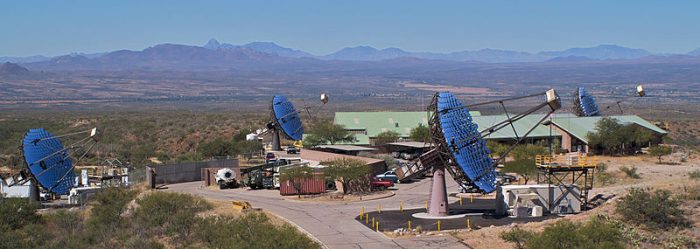The Search for Extraterrestrial Life (SETI) is the quest to find evidence of life outside our own world... as well as the origins of life overall.
For decades, SETI projects have searched outer space for radio signals. Any repeating pattern or unusual message that would suggest that we're not alone (even if we're still separated by thousands of light years). But now, scientists at a SETI project called Breakthrough Listen are expanding this search from things we can hear to things we can see.
Specifically, pulses of light.
Leave the light on

The VERITAS telescope array, found in Mount Hopkins, Arizona. (VERITAS/Wikimedia Commons)
When you think about it, it makes sense. After all, nothing travels faster than light. When ships needed a warning of the hazards of a rocky shore, it was a lighthouse that delivered that message. So are there alien lighthouses?
If they do exist, then the Very Energetic Radiation Imaging Telescope Array System, or VERITAS, is the device to find them. Wow, can we just take a moment to appreciate that name?
Hello, pleased to meet you. Last name: System. First name: Very. But you can call me... VERITAS!
So cool! Anyway, where were we? Right! Alien lighthouses!
From gamma rays to lasers

An up-close look at the mirrors on one of the 12-metre dishes. (Wars/Wikimedia Commons)
A problem with any sort of long-distance light-based communication is that it would need to be extremely powerful to be seen by us. E.T. standing on a mountain with a laser pointer isn't going to cut it. And even a very powerful artificially generated source of light is going to pale next to the light energy of stars.
This is where VERITAS comes in. It was built to scan the heavens for gamma rays in a particular way. As gamma rays reach Earth and hit our atmosphere, they produce a particular flash of pale blue light. These are impossible for any of us to detect. But for VERITAS? It's easy.
This telescope array's ability to detect extremely brief, faint light make it ideal to search for examples of unusual, dim light pulses across the cosmos!
Or as Breakthrough Listen's founder Yuri Milner puts it in a recent statement: "Our philosophy is to look in as many places, and in as many ways, as we can. VERITAS expands our range of observation even further.”
Light it up!
 "Did someone leave the light on out there? Anybody?" (© Evgenii Puzanov - Dreamstime.com)
"Did someone leave the light on out there? Anybody?" (© Evgenii Puzanov - Dreamstime.com)









